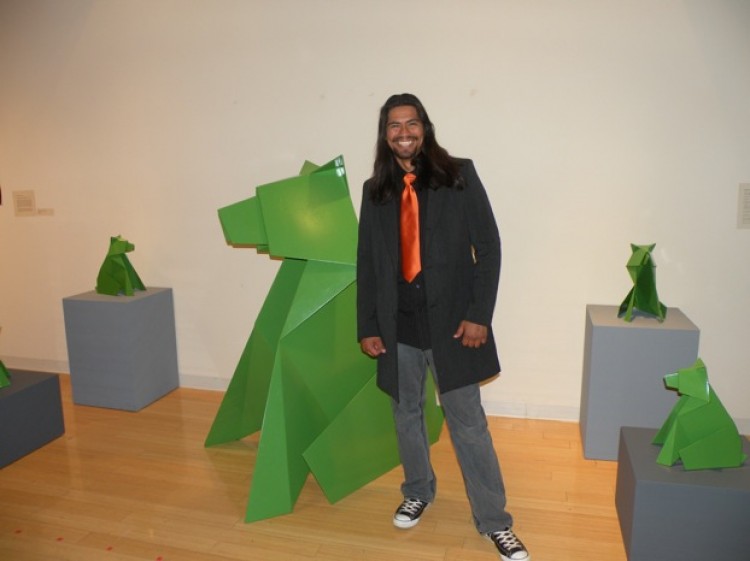
Biography
Renown for his bold, origami-inspired, metal sculptures that explore psychologically complex themes; Gerardo Hacer’s introduction to the nostalgic art form began at age seven when a volunteer in one of his foster homes read, “Sadako And The Thousand Paper Cranes” by Eleanor Coerr.
His reductive reinvention of the aesthetic evolved technically over decades along with its conceptual counterpart which is an amalgamation of exposure to Alexander Calder’s bold, playful sculpture and [after recruitment by renown art fabricator, Peter Carlson] first hand working knowledge of Jeff Koons’ steadfast attention to detail and Ellsworth Kelly’s exhaustive commitment to minimalism.
The perfection of his technique in combination with monumental vision have manifested museum and national art fair exhibitions and realized massive, permanent sculptural installations.
Permanent installations include Wynn Macau Luxury Resort, The Los Angeles Pacific design Center, University Hospitals Case Medical Center in Cleveland, OH; Los Angeles Trade Technical College and Autry National Center Southwest Museum.
Artist Statement
Born to teenage, Mexican-American gang members; I was abandoned at three months old and placed in a series of foster homes.
Lost in a lifestyle of violence/drug abuse, I escaped by creating a playful world that evolved from origami cranes.
In time my escape escaped me, I became the lifestyle with one reach: death.
In its grasp, I found Calder’s massive, red-orange, Los Angeles sculpture, “The Four Arches”. He/it gave me a new reach: life.
I decided I am not what happened to me, I am my response.
I broke from the violence of my birth name “Gomez-Martinez” by choosing “Hacer” [Spanish verb: “To make”] and became a sculptor who designs/builds large-scale, metal, origami-inspired forms in bold, solid colors.
It is the choice to be, as Calder and those like him, my part in a creative process that is bigger than me individually but impossible without the “me’s” collectively.
As I learn to shape my work, afraid, I move forward through the familiar unknown and learn to re-shape myself, lessening the past’s grip.
Like the dynamic, formative process hidden by my seemingly simple designs; my work’s simple existence aims to elicit a dynamic response about the viewer’s relationship to their formative process: childhood.
Through this interaction, we [like I with Calder] can all begin anew.
- HACER
Renown for his bold, origami-inspired, metal sculptures that explore psychologically complex themes; Gerardo Hacer’s introduction to the nostalgic art form began at age seven when a volunteer in one of his foster homes read, “Sadako And The Thousand Paper Cranes” by Eleanor Coerr.
His reductive reinvention of the aesthetic evolved technically over decades along with its conceptual counterpart which is an amalgamation of exposure to Alexander Calder’s bold, playful sculpture and [after recruitment by renown art fabricator, Peter Carlson] first hand working knowledge of Jeff Koons’ steadfast attention to detail and Ellsworth Kelly’s exhaustive commitment to minimalism.
The perfection of his technique in combination with monumental vision have manifested museum and national art fair exhibitions and realized massive, permanent sculptural installations.
Permanent installations include Wynn Macau Luxury Resort, The Los Angeles Pacific design Center, University Hospitals Case Medical Center in Cleveland, OH; Los Angeles Trade Technical College and Autry National Center Southwest Museum.
Artist Statement
Born to teenage, Mexican-American gang members; I was abandoned at three months old and placed in a series of foster homes.
Lost in a lifestyle of violence/drug abuse, I escaped by creating a playful world that evolved from origami cranes.
In time my escape escaped me, I became the lifestyle with one reach: death.
In its grasp, I found Calder’s massive, red-orange, Los Angeles sculpture, “The Four Arches”. He/it gave me a new reach: life.
I decided I am not what happened to me, I am my response.
I broke from the violence of my birth name “Gomez-Martinez” by choosing “Hacer” [Spanish verb: “To make”] and became a sculptor who designs/builds large-scale, metal, origami-inspired forms in bold, solid colors.
It is the choice to be, as Calder and those like him, my part in a creative process that is bigger than me individually but impossible without the “me’s” collectively.
As I learn to shape my work, afraid, I move forward through the familiar unknown and learn to re-shape myself, lessening the past’s grip.
Like the dynamic, formative process hidden by my seemingly simple designs; my work’s simple existence aims to elicit a dynamic response about the viewer’s relationship to their formative process: childhood.
Through this interaction, we [like I with Calder] can all begin anew.
- HACER